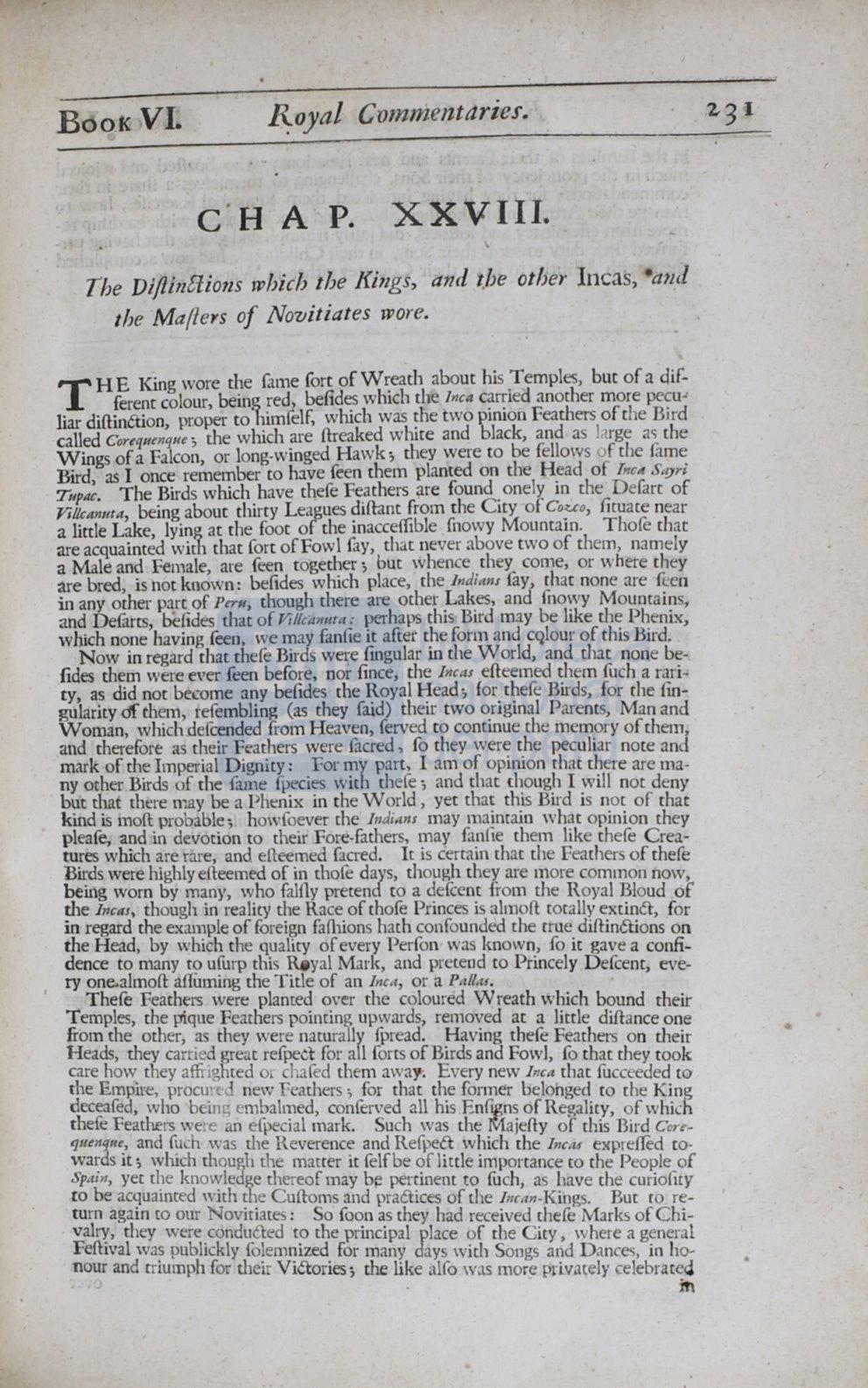

BooK
VI.
~oyal
Commentaries.
XXVllI.
.
The Diftinflions which the Kings, and t,he other
Incas,
and
the
Ma(le1s of Novitiates wore.
T
HE King wore the
fame fort
of W
~each
about his .Temples, but of
a
dif–
ferent colour, being red, befides which the
Inca
c~r~1ed
another more
pe~u..:
liar
dHl:inCtion, pr.aper to him(elf, which was
~he
two p1mon Feathers of the Bird
called
Corequenque;
the which are ftreaked white and black, and as large
as
the
, Wings of a Falcon or long-winged Hawk; they were to be fellows
of
the fame
Bird
as
I
once re:nember
co
have feen them planted on the Head o
Inca Sqyri
Tuple.
The Birds which have thefe Fe_athers are found .onely in the Defart of
Y,/lcanuta,
being
about thirty Leagues
~hfl:ant
from the City of
Co~o,
fimate
near
a
little
Lake,
lying at the foot of the rnacceffible .fnowy Mountain. Thofe that
are acquainted with that
fort
ofFowl fay, that never above two of them, namely
a
Male and Female are feen together; but whence they come, or where they
are bred,
is
not
ko~wn:
befides which place, the
Indians
fay, that none are feen
in
any other part of
Pent,
though there are other Lakes, and fnowy Mountains,.
and Detirrs, befides that of
Viltcanuta :
perhaps this Bird may be like the Phenix,
which none having feen, we may fanfie it after the form and CQlour of this Bird.
Now
in
regard that thefe Birds were fingular
in
the World, and that none be–
fides them were ever feen before, nor fince, the
Incas
efteemed them fuch
a
rari–
ty, as did not become any befides the Royal Head;
for
thefe Birds, for the
fin–
gularity
.of
them, refembling (as they faid) their two original Parents, Man
and
Woman, which defcended
from
Heaven, ferved to continue the memory of them,.
and
therefore as their Feathers were facred .,
fo
they were the peculiar note and
mark -of the Impeirial Dignity : For my part,
I
am of opinion that there are
ma–
ny other Birds of the fame fpecies with the[e; and that though
I
will
not deny
but that there may be
a
Phenix in the World , yet that this Bird is not of that
kind
is
mofr probable; howfoever the
Indians
may maintain what opinion they
pleafe, and
in
devotion to their Fore-fathers, may fanGe them like thefe Crea–
tures which are rare,
and
efieemed facred.
It
is certain that the Feathers of thefe
Birds were highly efieerned of
in
thofe days, though they are more common now,
being worn by many, who faHly pretend to a defcent from the Royal Blood
of
the
lnca.r,
though
in
reality the Race of rhofe Princes is almoCT: totally extinet, for
in
regard the exan1ple of foreign fafi1ions hath confounded the true difl:inttions on
the Head,
by
which the quality ofevery Perfon was known,
fo
it
gave
a
confi–
dence
to
many to uforp this
yal Mark, and pretend to Princely Defcent,
eve-
• ry
one.almofr
affurning
the Title of
an
Inca,
or
a
PallM.
Thefe Feathers were planted over the coloured Wreath which bound their
Temples, the pique Feathers pointing upwards, removed
at
a little dillance one
ftom the other,
as
they were naturally fpread. Having thefe Feathers on their
Heads, they carried great refped: for all forts of Birds and Fowl,
fo
that they took
care how they affi1ghted o
afed them away. Every new
Inca
that fucceeded
to
the
Empire, procu
new
athers; for that the former belonged to the King
deceafed, who beim; embalr?ed, con[erved all
his
Enfigns of Regality, of whi
h
thefe
Feathers
were
n
efpec1al
mark.
Such was the 1V1ajefiy of this
Bird
Core–
quenque!
and~
was
the Reverence and Refpeet which the
IncM
expreffed to–
wa~ds
it;
whICh though the matter it felf be of little importance to the People of
Spam,
yet tl!e
kno~ledge
thereof may be pertinent to fuch, as have the curiofity
robe
ac9uamted
with
~1-~e
Cufroms and praetices of the
Jncan-Kings.
But ro re–
turn agam to our Novmates: So foon as they had received thefe Marks ofChi–
valry,
they were .conduCl:ed
t?
the principal place of rhe City, where a general
Fefhval
wa~
pubhckly
fo!em~ized.
for many days with Songs and Dances, in ho–
nour and cnumph for their V iCtones;
the
like alfo was more
privately
celebrat~d














